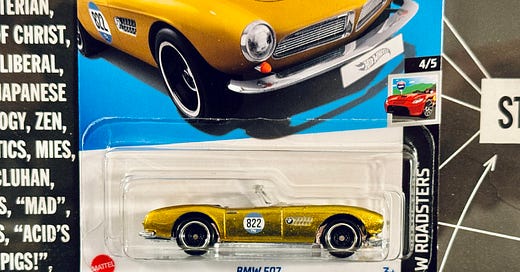The Hot Wheels Treasure Hunt Edition
On golden tickets, toy scalpers, and the allure of the limited edition.
Today’s archive pull still tickles me. Who knew Hot Wheels produces a tiny amount of ‘Super Treasure Hunt’ editions every year, Willy Wonka Golden Ticket style, and sells them at random stores across the country? – LC
Ryan McManus (RMM) is head of Competitive Intelligence at Ford and a longstanding friend of WITI. He has previously written about the fate of concept cars, the mystery of the Mystic Cobra, the simple elegance of SecuriCode, and how to start your own town. He owns a disgusting number of Hot Wheels. Really, it’s too many.
Ryan here. A few weeks ago, on an otherwise unremarkable trip to my local grocery store, a miracle awaited. Hanging from a peg in aisle 4 (juice, sodas) next to the Polar Dry was a 1:64 scale, die-cast BMW 507 in metallic gold Spectraflame™ finish, sitting on rubber RealRider™ tires. To the average shopper, this would appear as just another toy car sprinkled throughout the store to entice bored children. But to a very particular type of collector, it was like finding the Chachapoyan Fertility Idol sitting next to a “Wine a Little, Laugh a Lot” sign on a shelf at HomeGoods.
It was a Hot Wheels Super Treasure Hunt car.
Why is this interesting?
Hot Wheels started making toy cars in 1968, but in 1995 Mattel launched a new idea: A Treasure Hunt series. 12 models a year, released once a month, with a run then limited to ~10,000 units. These hard-to-find editions were conceived especially for the (usually adult) collectors, using simple supply constraint and random case assortment to create a “Wonka golden ticket” experience, where a lucky random collector would stumble across a T-Hunt car in the wild (or, tragically, the uninitiated would buy it for their kid and it would vanish into a toy bin forever).
That same year, another product would launch that would alter the trajectory of Mattel’s intentions: eBay.
Since 2007, there has been a second, rarer, and more coveted version of the Treasure Hunt cars: Super Treasure Hunt. Whereas the original cars were regular editions in special packaging, STH cars are actually of higher quality, sporting Spectraflame metallic paint jobs, all-metal bodies, and rubber tires on wheels. This lends a rarefied air to the item—not only are they difficult to find, but the object itself is elevated. Special.
So special that the value delta between the sale price of a STH car (as low as $0.99—Mattel has famously fought to keep the price of Hot Wheels accessible) and its market value (~$40, though they can go much higher) has made them a prime target for scalpers.
Which brings us back to that other mid-90s invention: eBay. The introduction of a perpetual global marketplace accelerated toy collecting from a hobby to an economy. Whereas selling a rare Hot Wheels car before might have been done at a convention, eBay meant access to buyers and sellers everywhere, all the time. And as the hobby grew, so did the profitability of being a reseller.
It’s believed that most Treasure Hunt and Super Treasure Hunt cars actually never make it to the shop pegs—cases are rifled through by savvy stockroom employees* (or even sold before they ship from the factory), or at best are hunted by resellers who know a store’s restocking schedule and wait, sometimes for hours, for a pallet to appear. And like so many other hobbies, the pandemic’s mix of boredom and supply constraint seems to have only made it worse. Even some regular “mainline” Hot Wheels can fetch an 8X profit, so you can imagine how profitable flipping STH cars for 50X every month could be.
*Full disclosure here: I was one of these people. I used to work in a stockroom of a large toy store chain in the late 90s and my coworkers would regularly open and look for rare toys in shipments before stocking the shelves, even before the Internet told us what to look for. I tried to be Robin Hood about it, though—hiding valuable action figures until I saw a kid in the aisle and then casually putting it out on the peg so they got that thrill of finding the one they were searching for. I’m a softie, sue me.
All of this is why my coming across a Super Treasure Hunt in a random aisle of a Big Y supermarket in the middle of Massachusetts was such a miracle—the odds of finding one are already rare, and the odds of finding one before a reseller does are almost zero. I had given up all hopes of lucking into one in the wild. I have even stopped scanning mainline pegs for them. They had become a myth, a fun and exciting fable that had been corrupted by the unrelenting greed of market economics.
But there it was, in Aisle 4—shining like that ol’ fertility idol, just waiting for someone to discover it.
As I slipped it gently from its peg and carried it like a baby bird to the checkout lane, I couldn’t help but feel happy that in this moment, the idea dreamt up by some anonymous Mattel employee had happened just as they had envisioned: Stumbled upon in the wild, the tremulous moment of realization of what I had found, and the thrill of seeing the glint of a golden ticket tucked into an unremarkable chocolate bar wrapper.
I’ll never sell mine, though. It is, after all, for the kids. (RMM)
—
Why is this interesting? is a daily email from Noah Brier & Colin Nagy (and friends!) with editing help from Louis Cheslaw about interesting things. If you’ve enjoyed this edition, please consider forwarding it to a friend. If you’re reading it for the first time, consider subscribing.





The perfect WITI.